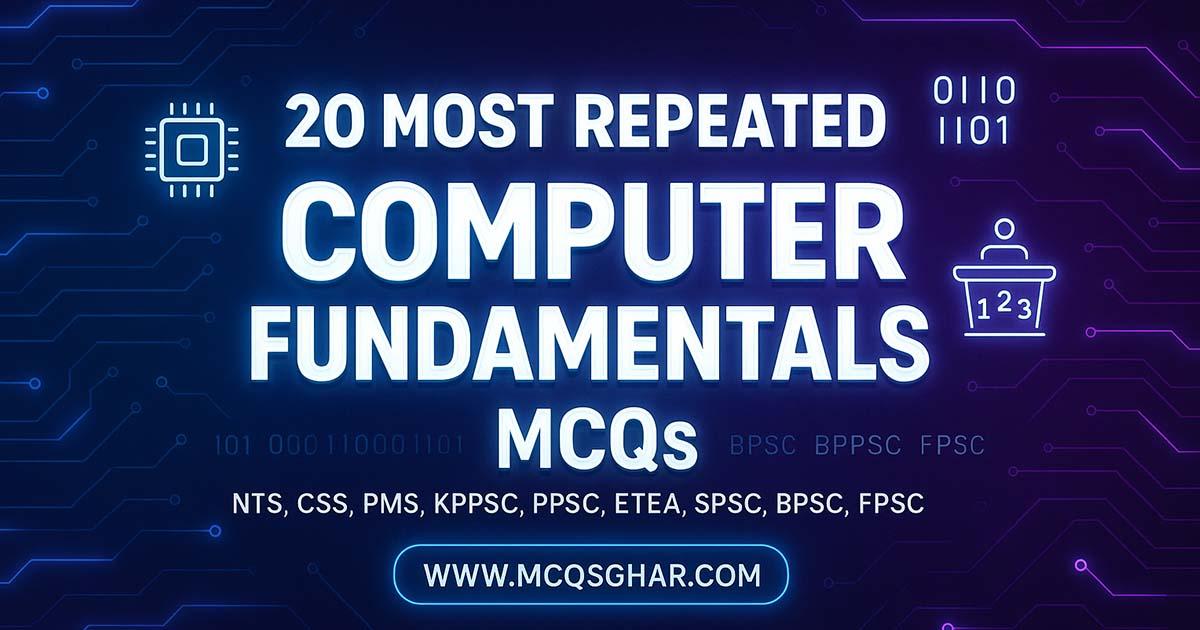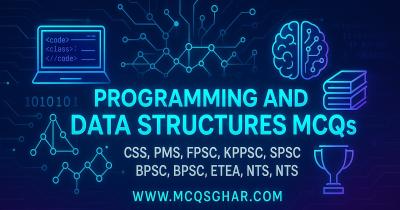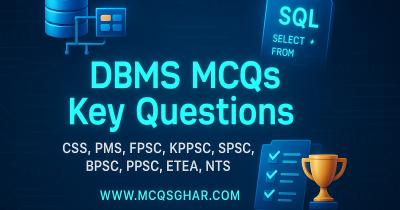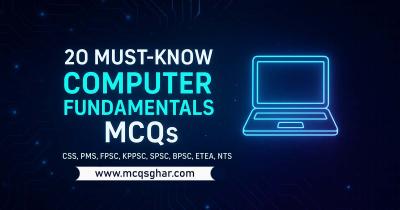بِسْمِ اللَّهِ الرَّحْمَنِ الرَّحِيم
20 Most Repeated Computer Fundamentals MCQs for NTS, CSS, PMS, KPPSC, PPSC, ETEA, SPSC, BPSC, and FPSC
Are you preparing for a competitive exam like the NTS, CSS, PMS, KPPSC, PPSC, ETEA, SPSC, BPSC, and FPSC? A strong grasp of Computer Fundamentals is the first and most critical step to success for any IT-related post, from Computer Operator to Assistant Director IT. An analysis of past papers shows that a significant portion of questions is dedicated to these core concepts.1 This section tests your basic understanding of what a computer is and how it works.
To help you build a solid foundation, we have curated 20 of the most frequently repeated Computer Fundamentals MCQs. These questions cover everything from computer generations to basic hardware and software. More importantly, each question comes with a clear, detailed explanation to help you learn the concept, not just memorize the answer. Let's begin!
Most Repeated Computer Fundamentals MCQs
1. Who is widely known as the father of Computers?
- James Gosling
- Charles Babbage
- Dennis Ritchie
- Alan Turing
Answer: Charles Babbage
Explanation: Charles Babbage, an English mathematician, is credited with originating the concept of a programmable computer. He designed the first mechanical computer, the Difference Engine, and the more complex Analytical Engine, which laid the foundation for modern computing.
2. The main electronic component used in first-generation computers was:
- Transistors
- Integrated Circuits
- Vacuum Tubes and Valves
- Microprocessors
Answer: Vacuum Tubes and Valves
Explanation: First-generation computers (roughly 1940-1956) relied on vacuum tubes as their primary electronic component for circuitry and memory. These computers were massive, expensive, and generated a lot of heat.
3. Which of the following is the brain of the computer?
- Memory
- Control Unit
- Arithmetic and Logic Unit (ALU)
- Central Processing Unit (CPU)
Answer: Central Processing Unit (CPU)
Explanation: The Central Processing Unit (CPU) is called the brain of the computer because it performs most of the processing. It interprets and executes program instructions. The CPU itself contains the Control Unit and the ALU.
4. Which type of memory is volatile, meaning its contents are lost when the power is turned off?
- ROM
- RAM
- PROM
- BIOS
Answer: RAM (Random Access Memory)
Explanation: RAM (Random Access Memory) is a volatile memory. It is used by the CPU to store data and programs that are currently in use. Because it requires power to maintain the stored information, all data is lost when the computer is shut down.
5. A byte consists of how many bits?
- 4 bits
- 8 bits
- 16 bits
- 2 bits
Answer: 8 bits
Explanation: A bit is the smallest unit of data in computing (a 0 or 1). A group of 8 bits is called a byte, which is the standard unit used to represent a character, like a letter or a number.
6. Which of the following is an example of an input device?
- Printer
- Monitor
- Scanner
- Speaker
Answer: Scanner
Explanation: An input device is any hardware that sends data to a computer. A scanner converts physical documents or images into a digital format that the computer can process. Printers, monitors, and speakers are output devices as they present data from the computer to the user.
7. Software designed to perform a specific task for users, such as a word processor or web browser, is known as:
- System Software
- Application Software
- Utility Software
- Firmware
Answer: Application Software
Explanation: Application software is created for end-users to perform specific tasks. Examples include Microsoft Word, Google Chrome, and Photoshop. System software, like the operating system, manages the computer's hardware and provides a platform for application software to run.
8. The process of starting or restarting a computer is called:
- Loading
- Prompting
- Booting
- Paging
Answer: Booting
Explanation: Booting is the process that starts the operating system when the computer is turned on. The BIOS (Basic Input/Output System) plays a key role in this process by initializing hardware and loading the operating system from the storage device into RAM.
9. A computer program that translates a high-level language program into machine language all at once is called a(n):
- Interpreter
- Compiler
- Assembler
- Debugger
Answer: Compiler
Explanation: A compiler scans the entire program and translates it as a whole into machine code. An interpreter, on the other hand, translates and executes the program line by line. Compilers generally produce faster-executing code.
10. What does 'GUI' stand for?
- Graphical Utility Interface
- Gaming User Interface
- General User Input
- Graphical User Interface
Answer: Graphical User Interface
Explanation: GUI stands for Graphical User Interface. It allows users to interact with electronic devices through graphical icons and visual indicators, as opposed to text-based command-line interfaces. Windows and macOS are primary examples of GUI-based operating systems.
11. Which device is required for an Internet connection?
- Joystick
- NIC Card
- Modem
- CD Drive
Answer: Modem
Explanation: A modem (Modulator-Demodulator) is a device that converts digital signals from a computer into analog signals for transmission over telephone lines, and vice versIt is essential for connecting to the Internet via a telephone line or cable.
12. A single point on a computer screen is called a:
- Cell
- Element
- Pixel
- Bit
Answer: Pixel
Explanation: A pixel (short for picture element) is the smallest controllable element of a picture represented on the screen. The resolution of a screen is determined by the number of pixels it can display horizontally and vertically.
13. Which of the following is a type of non-volatile memory?
- RAM
- Cache Memory
- DRAM
- ROM
Answer: ROM (Read-Only Memory)
Explanation: Non-volatile memory retains its data even when the power is turned off. ROM (Read-Only Memory) is a type of non-volatile memory that stores the firmware for the computer, such as the BIOS, which is needed to boot the system.
14. The programs which are as permanent as hardware and stored in ROM are known as:
- Hardware
- Software
- Firmware
- ROM ware
Answer: Firmware
Explanation: Firmware is a specific class of computer software that provides low-level control for a device's specific hardware. It is stored in non-volatile memory chips like ROM or flash memory, making it difficult to modify.
15. A computer is free from tiredness and boredom. We call this characteristic:
- Accuracy
- Reliability
- Diligence
- Versatility
Answer: Diligence
Explanation: Diligence is the characteristic of a computer that allows it to work for hours without getting tired or making errors due to fatigue. This makes computers ideal for performing repetitive tasks with consistent performance.
16. Which of the following is the largest unit of storage?
- Gigabyte (GB)
- Kilobyte (KB)
- Megabyte (MB)
- Terabyte (TB)
Answer: Terabyte (TB)
Explanation: The units of digital storage are ordered as follows: Kilobyte (KB), Megabyte (MB), Gigabyte (GB), Terabyte (TB), and Petabyte (PB). Each unit is 1024 times larger than the previous one, so a Terabyte is the largest unit listed.
17. What does CPU stand for?
- Computer Processing Unit
- Central Processing Unit
- Computer Principle Unit
- Control Processing Unit
Answer: Central Processing Unit
Explanation: CPU stands for Central Processing Unit. It is the primary component of a computer that executes instructions and is often referred to as the computer's "brain".
18. A hybrid computer:
- Resembles a digital computer
- Resembles an analog computer
- Resembles both a digital and an analog computer
- None of the above
Answer: Resembles both a digital and an analog computer
Explanation: A hybrid computer combines features of both analog and digital computers. It uses the analog component for solving complex mathematical equations and the digital component to act as the controller and provide logical operations.
19. Which language does a computer understand directly without any translation?
- C Language
- Assembly Language
- Machine Language
- Java
Answer: Machine Language
Explanation: Machine language, which is composed of binary code (0s and 1s), is the only language a computer's CPU can understand and execute directly. All other languages, like C or Assembly, must be translated into machine language by a compiler or assembler.
20. The raw, unprocessed facts and figures are called:
- Information
- Data
- Output
- Program
Answer: Data
Explanation: Data refers to raw facts, figures, and symbols that have not been processed or organizeWhen data is processed, organized, and structured to make it useful, it becomes information.




